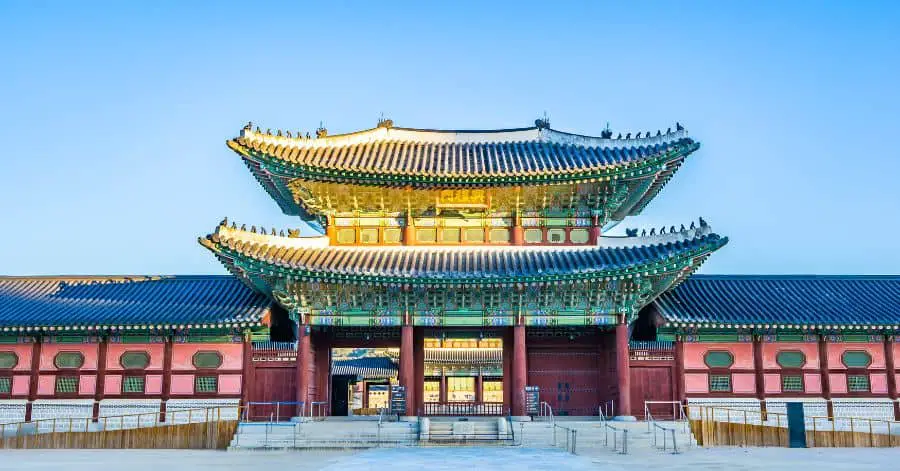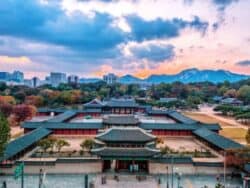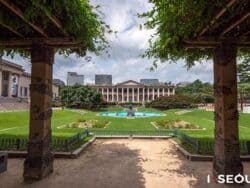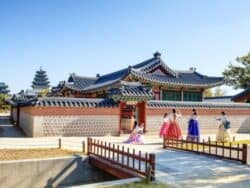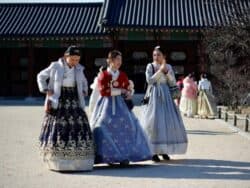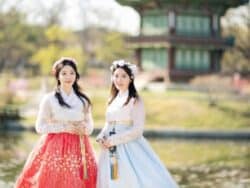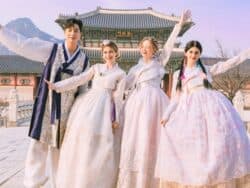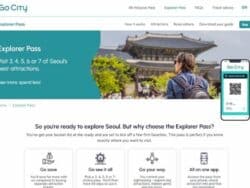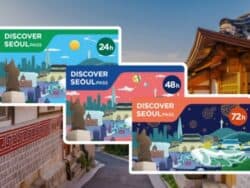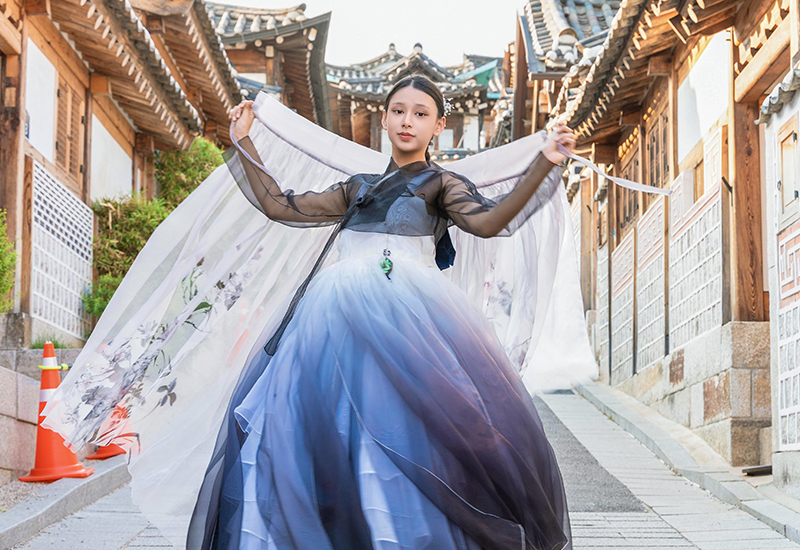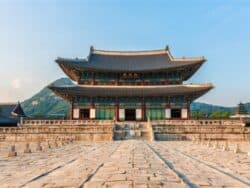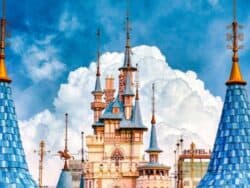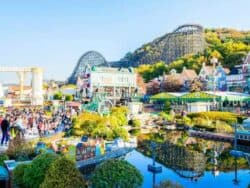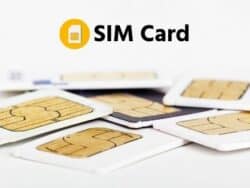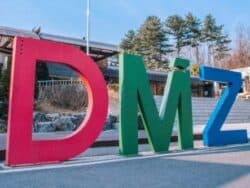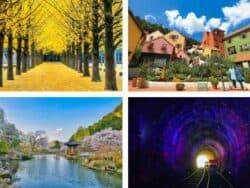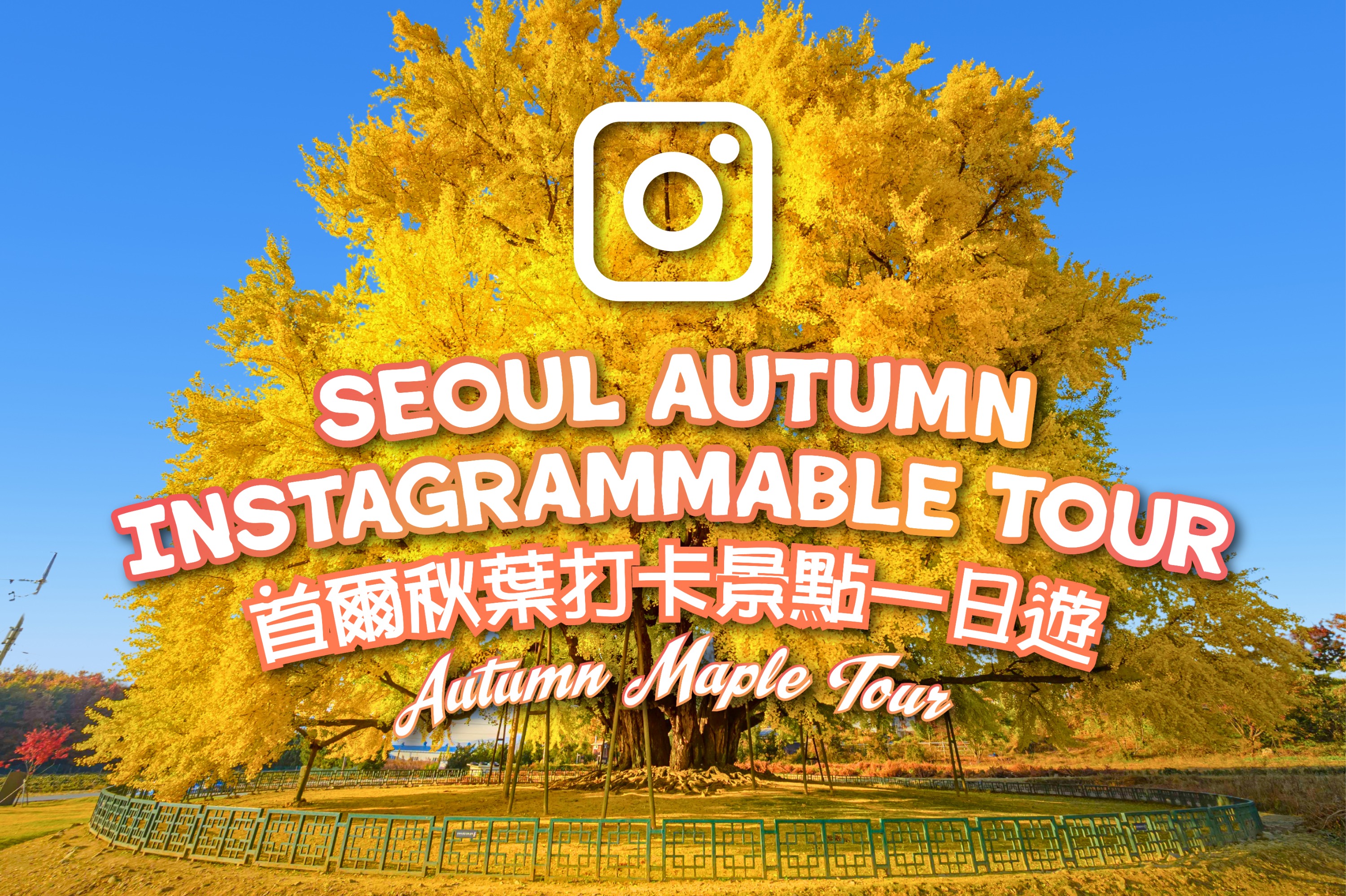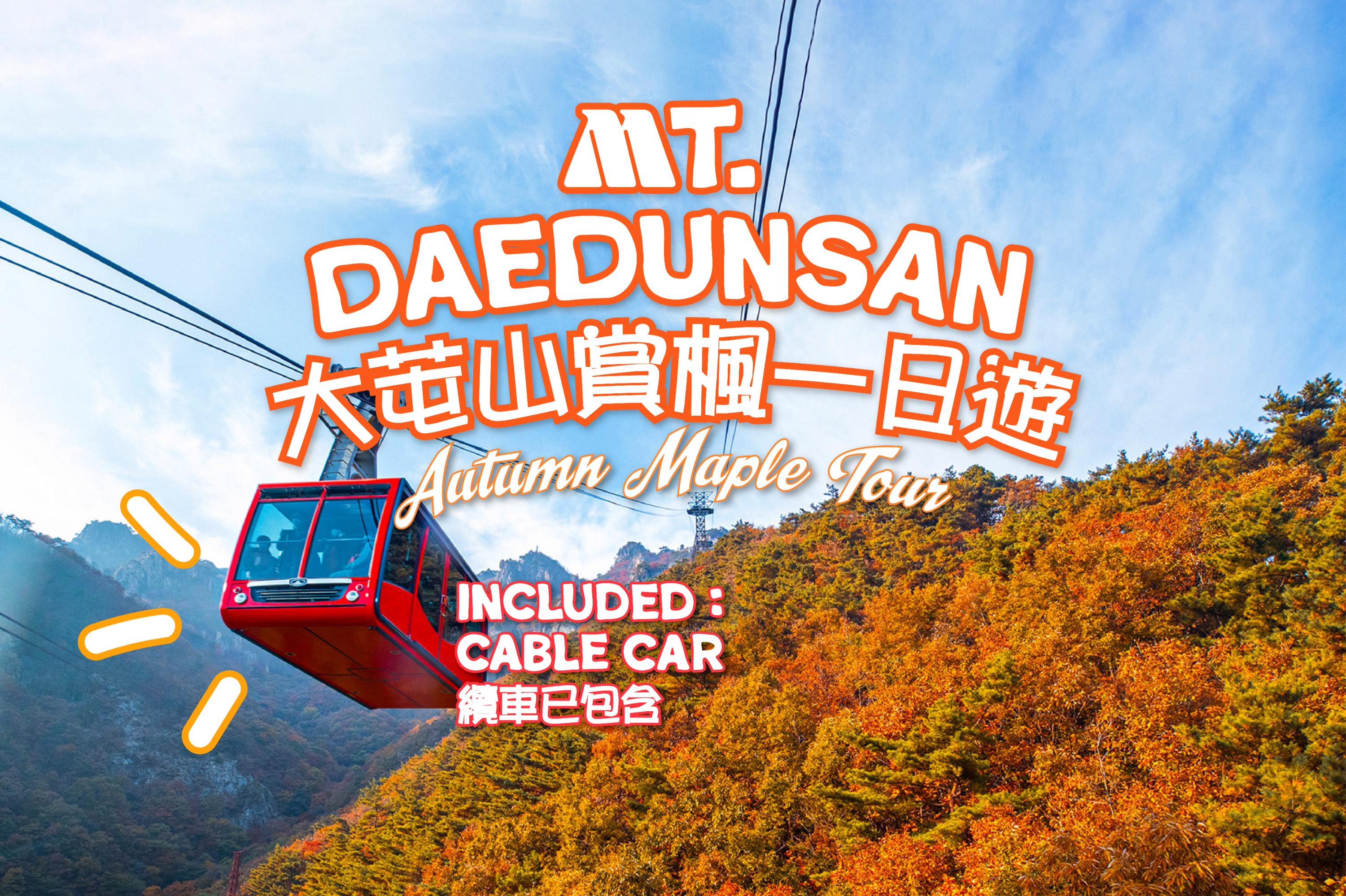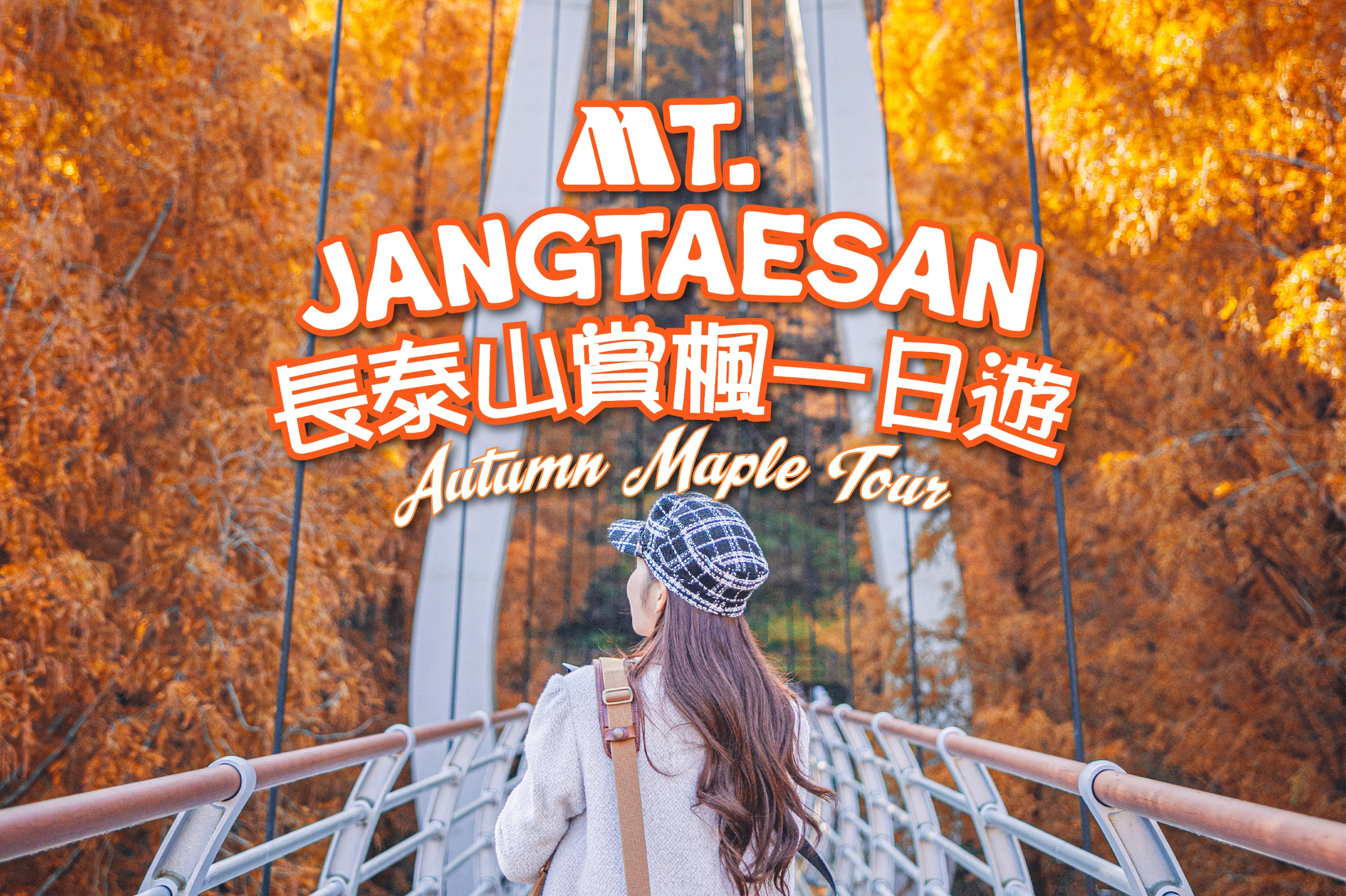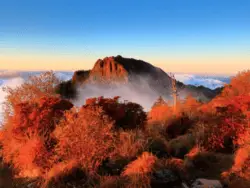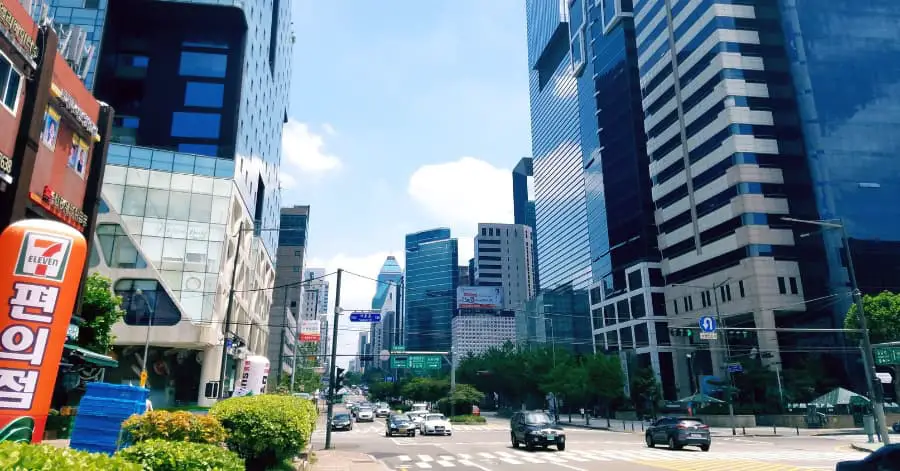📍 161, Sajik-ro, Jongno-gu, Seoul | 서울특별시 종로구 사직로 161
🚆 Seoul Subway Line 3 to Gyeongbokgung Station Exit 5
🕒 January-February, November-December 09:00-17:00 | March-May, September-October 10:00-18:00 | June-August 09:00-18:30 | Last admission 1 hour before close | Closed on Tuesdays
₩ Adults (Ages 19-64) 3000 KRW ($2.26) | Group admission (10+ people) 2400 KRW ($1.81) | Ages under 18 and above 65 and people wearing Hanbok can visit for free.
🌐 https://www.royalpalace.go.kr
☎️ +82 2-3700-3900
✍🏻 Insadong, Hanok Buckchon Village, and Seochon Village are all nearby.
How to get there Gyeongbokgung Palace
Address: 161, Sajik-ro, Jongno-gu, Seoul | 서울특별시 종로구 사직로 161
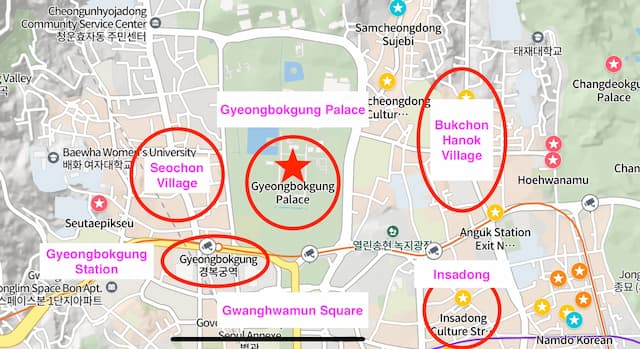
By Subway
You can take subway line 3 (Exit 5) to Gyeongbokgung Station. This station is only a short distance from the palace. This is also the closest train station to the Gyeongbokgung Palace.
- From Myeongdong Station: Take the subway line 4 to Chungmuro Station. At that point, change to Subway Line 3 to reach Gyeongbokgung Station.
- From Seoul Station: Take the metro line 4 to Chungmuro Station, then switch to subway Line 3 to get to Gyeongbokgung Station.
- From Hongik University Station: Take the subway line 2 to Euljiro 3(sam)-ga Station. After that, switch to Subway Line 3 and head to Gyeongbokgung Station.
By Bus
From throughout Seoul, various bus lines will take you to Gyeongbokgung Palace. Each route stops at the Gyeongbokgung Palace bus station: bus numbers 0212, 1020, 1711, 7016, 7022, 1020, 109, 171, 272, 602, 602-1 (Airport Bus), 606, 7025, 708, and 9708.
By Seoul City Tour Bus
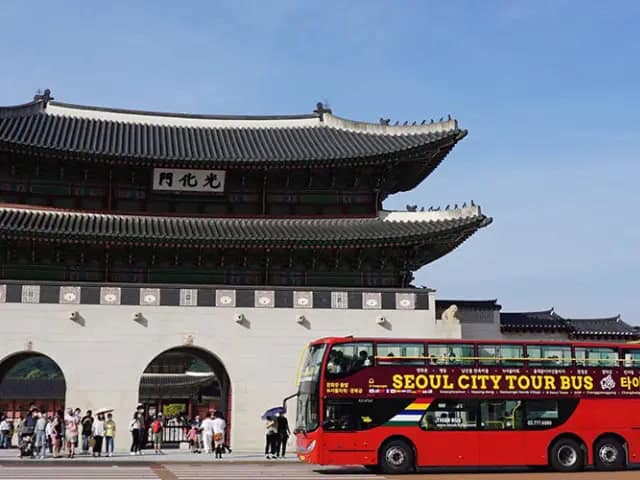
The Seoul City Tour Bus is another way to go to Gyeongbokgung Palace. This allows you to visit Seoul in your own time and see places other than the palace.
The Downtown Palace Namsan Course is recommended. The tour bus visits 15 locations, including Gyeongbokgung Palace, Insadong, Myeongdong, N Seoul Tower, and Dongdaemun. For more details, check out our post, Seoul City Tour Bus.
- Ticket: 24 USD for adults | 15 USD for children
- You can board after exchanging your physical ticket at the Gwanghwamun Stop ticket booth.
- With the pass, you can hop on and off the bus at any time during the day’s circular journey.
How to make the most of your visit to Gyeongbokgung Palace
- Book a Free Walking Tour of Gyeongbokgung Palace and explore this historical gem with a volunteer local guide. It’s a fantastic way to dive into the palace’s rich history and culture, all guided by someone who knows it best!
- There are free expert-guided tours in various languages, including Chinese, English, Japanese, Vietnamese, and Spanish. The tour lasts around 1 hour and 30 minutes and begins in front of the Gyeongbokgung Palace Information Center inside the Heungnyemun Gate. You can check the schedule above and arrive 30 minutes earlier to apply.
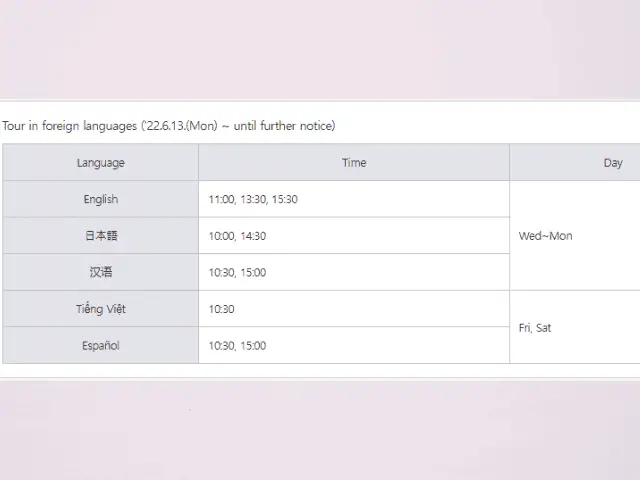
- When you visit wearing a hanbok, you will get stunning images and free entrance. Check out our hanbok renting guide.
- The changing of the Palace Guard Ceremony takes place in the square within Gwanghwamun Gate at 10:00 AM and 2:00 PM.
- The Gate Guard Duty Performance happens at 11:00 AM and 1:00 PM outside the Gwanghwamun Gate.
- The Royal Palace Pass: If you plan to visit multiple palaces in Seoul, you should buy this pass. The Royal Palace Pass is KRW 10,000 ($7.6) and is valid for three months after purchase. With the pass, you can visit Gyeongbokgung, Changdeokgung, Changgyeonggung, Deoksugung, and Jongmyo Shrine.
- Otherwise, you can make it easy with the Go City Seoul Explorer Pass, Discover Seoul Pass, or Klook Seoul Pass. These passes include access to Hanbok rentals near royal palaces, Lotte World, Folk Village, N Seoul Tower, Cookin’ Nanta Show, Everland Shuttle, DMZ Tour, Nami Island, Han River Cruise, Seoul Land, Dynamic Maze, Alive Museum, and even a Seoul Pub Crawl in Hongdae.
About Gyeongbokgung Palace
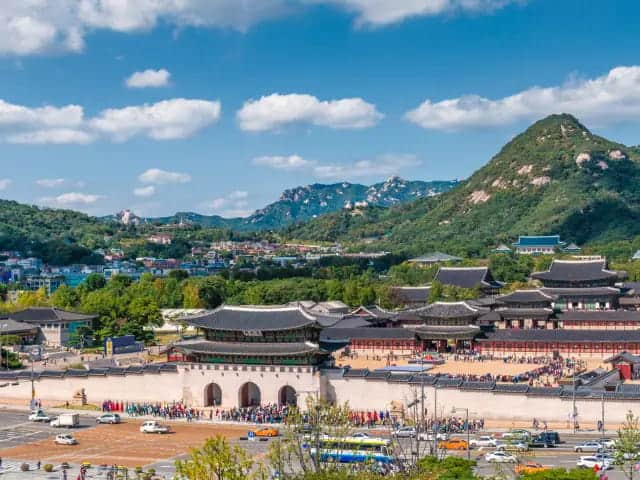

Gyeongbokgung Palace was built by Yi Seong-gye (later King Taejo) as the main royal palace of the Joseon dynasty. It’s the biggest and often considered the most beautiful of Seoul’s five palaces. Many kings of Joseon were crowned here, making it an important place in Korean history.
The palace was badly damaged by fire during the Imjin War (1592–1598), but it was later carefully rebuilt during King Gojong’s reign. Sadly, it also became known as the place where Empress Myeongseong was assassinated — an event that marked the beginning of the dynasty’s decline. Today, Gyeongbokgung stands as a powerful symbol of Korea’s long and rich history.
What to see in Gyeongbokgung Palace?
Gwanghwamun Gate
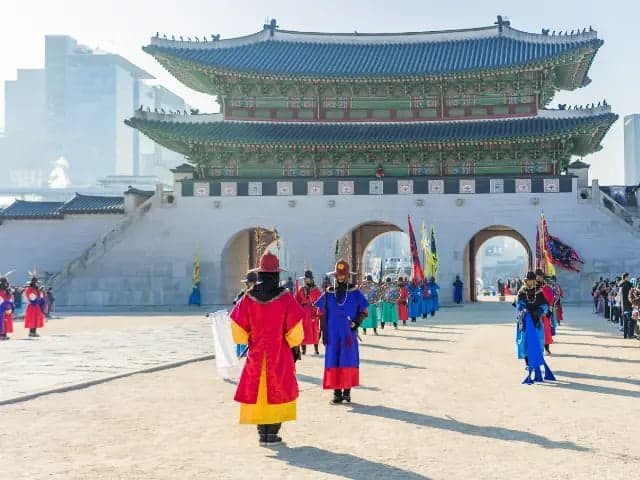
Gwanghwamun is the main gate of the Palace. At the front, there’s a statue of Haitai, a mythical creature believed to protect the city. The Changing of the Guards Ceremony, echoing Joseon Dynasty traditions, occurs twice daily (10 a.m. and 2 p.m., except Tuesdays) at the square inside Gwanghwamun. This reenactment, featuring authentic costumes and props, offers a rare glimpse into Korea’s royal past.
If you miss the ceremony, catch the Gate Guard Duty Performance at 11 a.m. and 1 p.m. outside Gwanghwamun gate. Though briefer, it showcases guards in traditional attire, providing a captivating snapshot of Korean cultural heritage.
Hyangwonjeong Pavilion
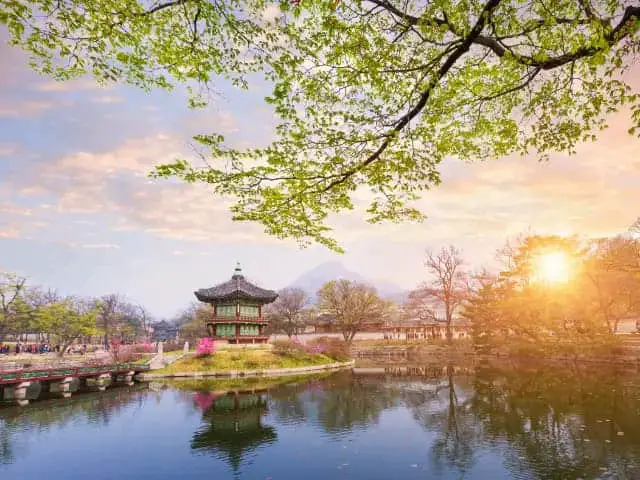
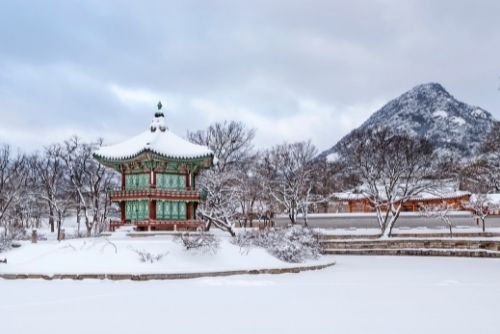
Hyangwonjeong was a spot for the king and royal family to take a break and relax. Its name, “Hyangwon,” means “scent spreading far.” It’s a cool hexagon building in Gyeongbukgung Palace’s backyard, marked National Treasure No. 1761. The place is so pretty, surrounded by a pond and connected by a fairytale-like bridge.
Unfortunately, the cute bridge to Hyangwonjeong Pavilion isn’t open for visitors often. But don’t worry, there are seats where you can relax and enjoy the pavilion from a distance. Come here and snap a picture. It will feel like you’re in your Korean drama!
Geunjeongjeon Hall
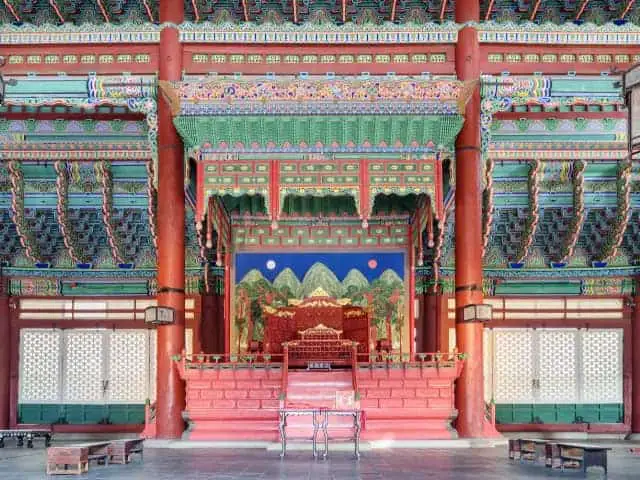
Geunjeongjeon is the top royal palace at Gyeongbokgung, symbolizing sincere governance. It’s the grandest building showcasing royal authority and designated National Treasure No. 223. This majestic hall hosted crucial national events, including coronations and receptions for foreign envoys.
Adorning the throne’s backdrop is a vivid painting depicting the Sun, Moon, and a five-peaked mountain. The ceiling is adorned with seven-clawed dragons representing the king and the state. In front, a stone-paved square shows the court officials lined up by rank during official events. If you’ve watched Korean dramas, you might recognize this historic setting.
Gyeonghoeru Pavilion
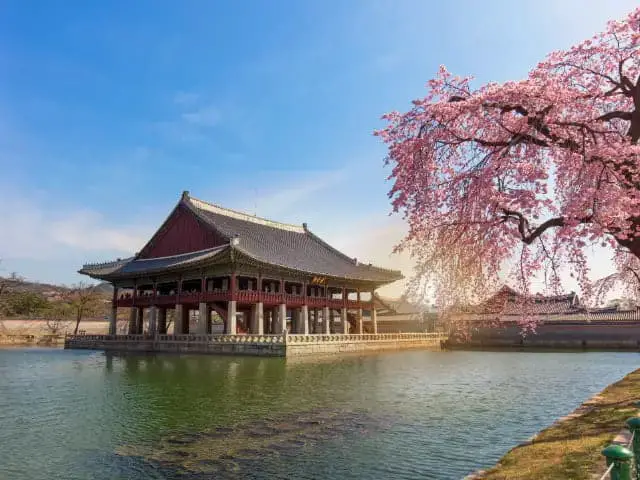
Gyeonghoeru, a unique banquet hall at Gyeongbokgung Palace, was the place for grand feasts with the king and foreign guests. Surrounded by a charming pond, it’s among the most stunning structures in the palace. Upstairs, you can enjoy splendid views of Inwangsan Mountain and the palace through the window framing. It just looks like a picture taken from movies.
Interestingly, the hall is believed to be built based on principles from the Book of Changes. The three central rooms symbolize heaven, earth, and man, while the 12 rooms represent each month, and the 24 exterior pillars correspond to the solar terms. Recognized as National Treasure No. 224, Gyeonghoeru holds historical and cultural significance.
National Folk Museum of Korea
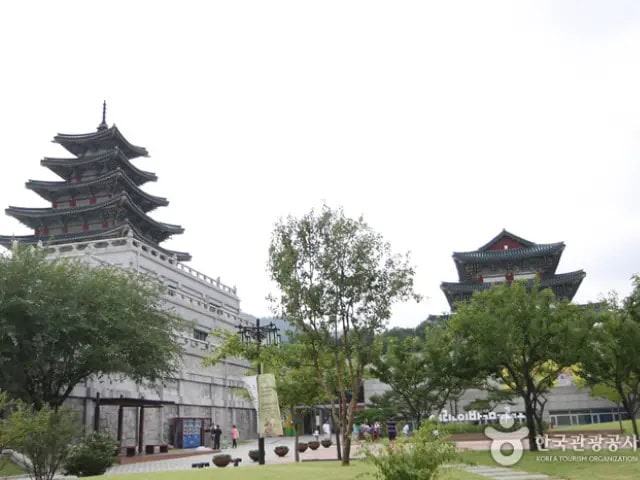
The National Folk Museum of Korea, located in Gyeongbokgung Palace, displays historical items from daily life in Korea’s past. You can explore exhibits on domestic life, agriculture, and cultural beliefs. The museum has permanent and special exhibitions, a library, and a souvenir shop. Best part? The entrance is free.
- Opening hours: March-May, September-October: 09:00-18:00 | June-August: 09:00-18:30 | November-February: 09:00-17:00
- Last admission is 1 hour before closing
- Last Wednesday, Friday & Saturday of each month open until 21:00
Geoncheonggung
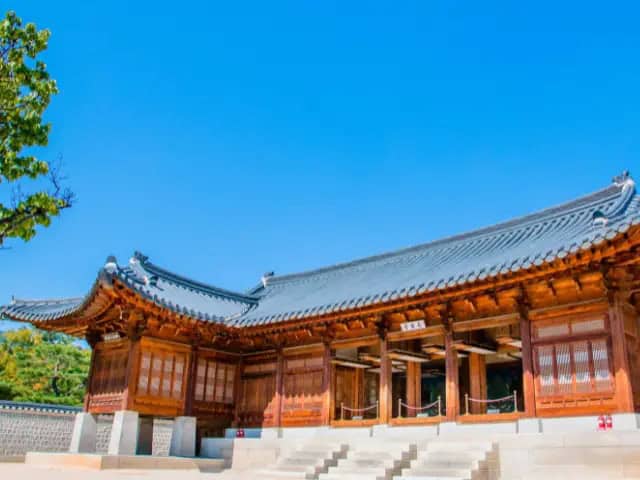
Constructed in 1873 at the northern end of Gyeongbokgung Palace, Geoncheonggung Palace served as the residence for King Gojong, the final monarch of the Joseon Dynasty, and his Queen Myeongseong. Restored in 2007, it’s a cool spot with an interesting twist—it was the first building in Korea with electric lights, just seven years after Edison’s light bulb. Now, it features a special exhibit on the Eulmi Incident, and you can check it out when you visit.
Sajeongjeon
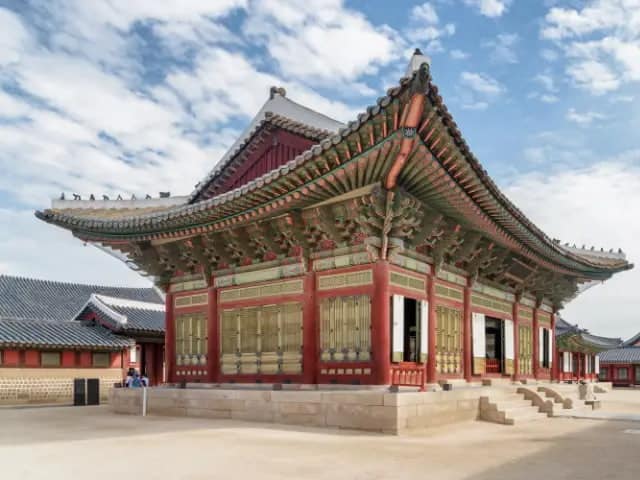
Sajeongjeon (Treasure No. 1759) was the primary office for the king’s state affairs during the Joseon Dynasty. Here, daily morning assemblies with top officials took place. It also doubled as the royal library, where the king studied Chinese classics alongside a small group of scholars, aiming to cultivate wisdom and discuss strategies for wise governance.
Gyotaejeon Hall
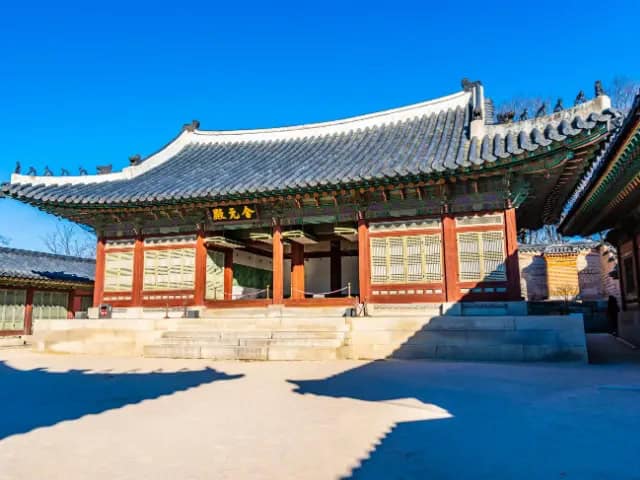
Gyotaejeon is the official residence of Joseon queen consorts (National Treasure No. 811). Over the years, it faced destruction, rebuilding, and dismantling before being carefully restored in 1995. Adjacent to Gyotaejeon is Amisan, a quaint garden. In times when palace women had limited access to the outside world, Amisan served as a delightful spot for relaxation and socializing. Adorned with flowers and ornamental chimneys, it provided a charming terrace for women to enjoy leisure and strolls.
Gyeongbokgung Palace Nighttime Opening
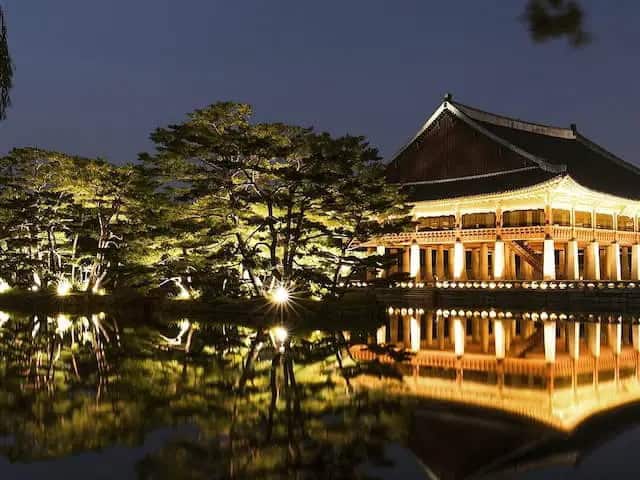
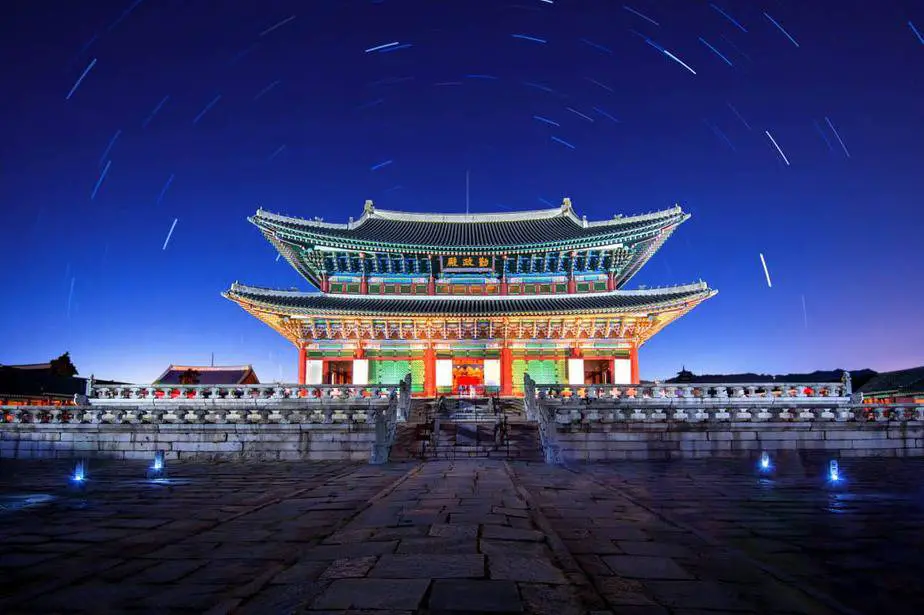
- Period: 2023.04.05 ~ 2023.05.31 | 2023.09.01 ~ 2023.10.29
- Open hours: 19:00 – 21:30 (Last entrance 20:30) Closed on Monday and Tuesday
- Admission: 3,000KRW | Free on wearing Hanbok
Gyeongbokgung Palace, a famous historic place in Seoul, will be open at night during spring (April to May) and autumn (September to October). Every year, lots of people want to go because it’s beautiful at night. To go, you usually need to book your tickets online, and it can be really hard to get them because many people want to go too. But here’s a tip: if you wear Hanbok, which is traditional Korean clothing, you can get in for free.
Stay tuned for more information about this special event, where you can feel like you’re back in time at Gyeongbokgung Palace.
Things to Do Near Gyeongbokgung Palace
Changdeokgung Palace
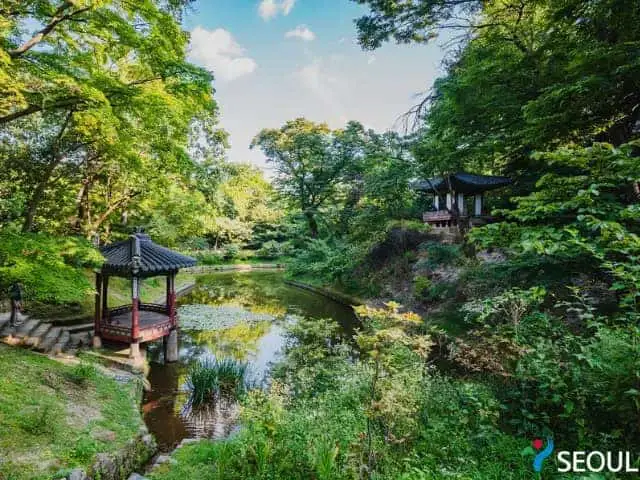
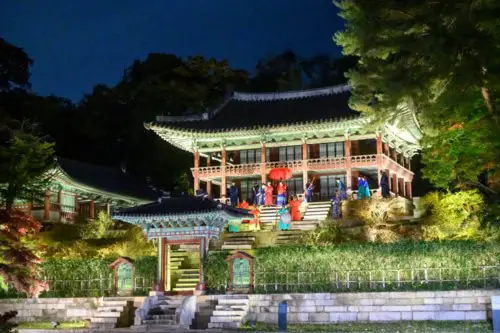
- Address: 99 Yulgok-ro, Jongno-gu, Seoul
- Open hours: 9:00 – 17:00 from Tuesday to Sunday | Closed on Mondays
- Admission: 3000KRW | Free on wearing Hanbok
- Phone: +82 2-762-8261
- Website: https://www.cdg.go.kr
Built in 1405 after Gyeongbokgung Palace, Changdeokgung Palace was a primary residence for Joseon dynasty kings. Changdeokgung Palace is located right to the east of Gyeongbokgung Palace, making it easily accessible. This palace is renowned for its beautiful Huwon (Secret Garden), a frequent backdrop in K-dramas. Among Seoul’s five ancient royal palaces, Changdeokgung stands out for its remarkable preservation, earning it a spot on the UNESCO World Heritage list. The garden is a must-see, particularly in fall when it transforms into a mesmerizing blend of vibrant colors, offering a serene, picturesque escape in the heart of the city.
Changdeokgung Palace 창덕궁: Ultimate Guide
Insadong Street
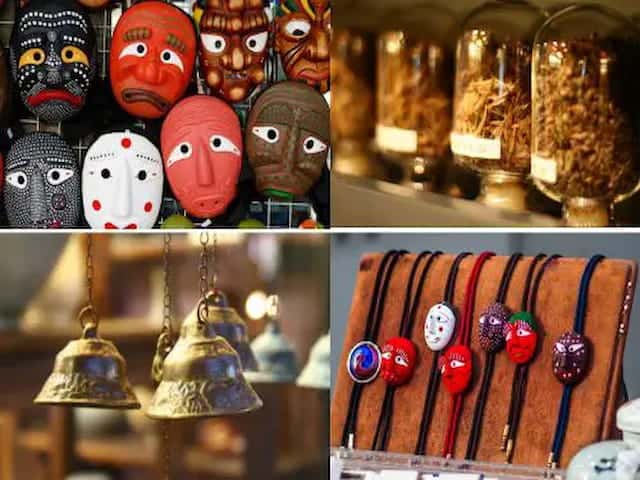
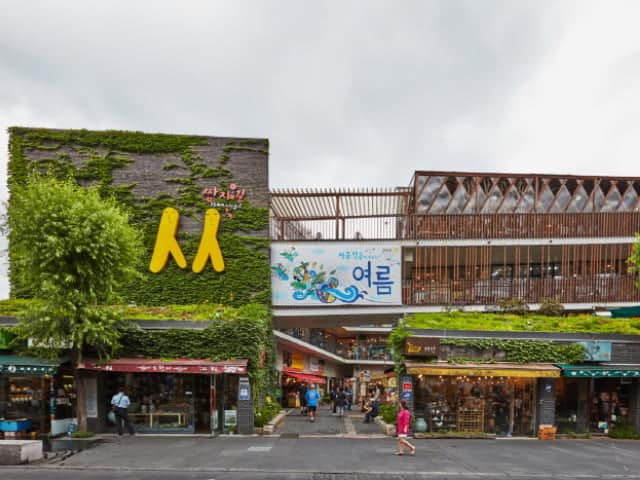
- Address: Insa-dong, Jongno-gu, Seoul
Insadong is a neighborhood where Korean Hanok architecture has been kept original. This is the place to fully immerse yourself in Korean culture. Insadong has many intriguing and appealing charms, but the most famous are the traditional architecture, art exhibitions, and a great number of cafés, tea shops, and restaurants with very beautiful concepts and décor.
Bukchon Hanok Village
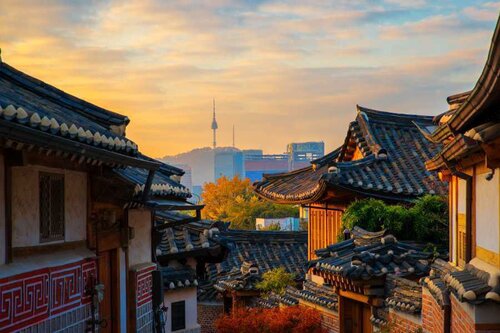
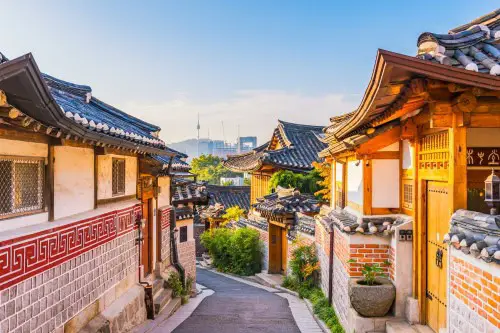
- Address: 37, Gyedong-gil, Jongno-gu, Seoul
Bukchon Hanok Village is considered Seoul’s most beautiful ancient village. Tucked between Changdeokgung Palace, Gyeongbokgung Palace, and Jongmyo Temple, it offers a tranquil escape from the bustling city. The village, with its traditional stone and clay houses, recreates the charm of the Joseon period.
You can explore galleries, small museums, and cozy cafes along the streets. A simple walk through the village provides ample opportunities to capture beautiful photos for your Instagram.
Seochon Village
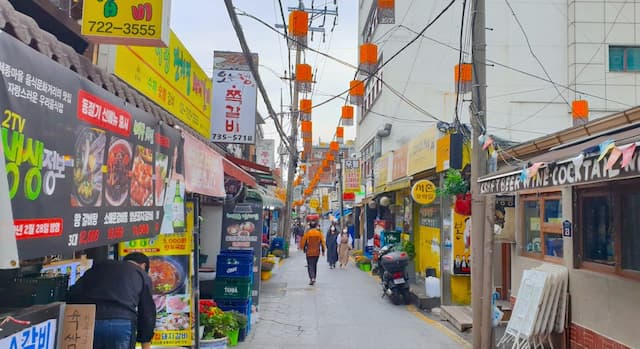
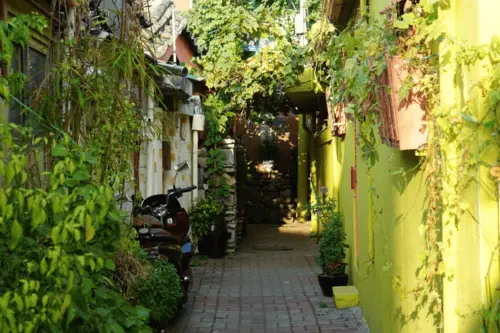
- Address: 45, Jongno-gu, Seoul (Good to start from Gyeongbokgung station exit 2)
Walking around Seochon Village was a really special experience. It’s a quiet neighborhood just west of Gyeongbokgung Palace, and it has a nice mix of old and new. The small streets are lined with traditional hanok houses, but you’ll also find cute cafes and art galleries. Every part of the village feels like it has a story, from its history with artists and writers to the creative vibe it has today.
Cheonggyecheon Stream
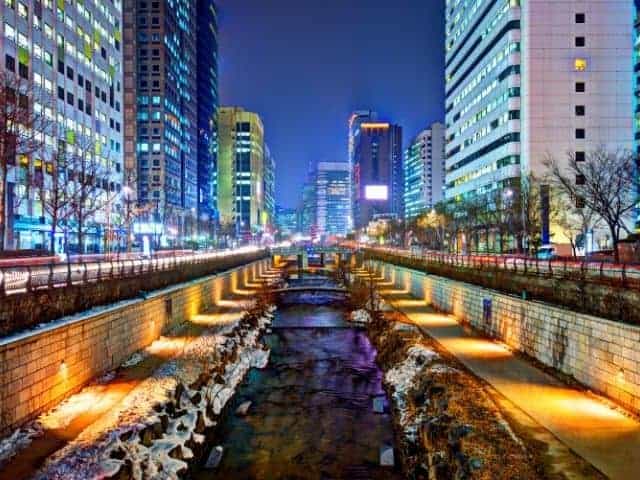
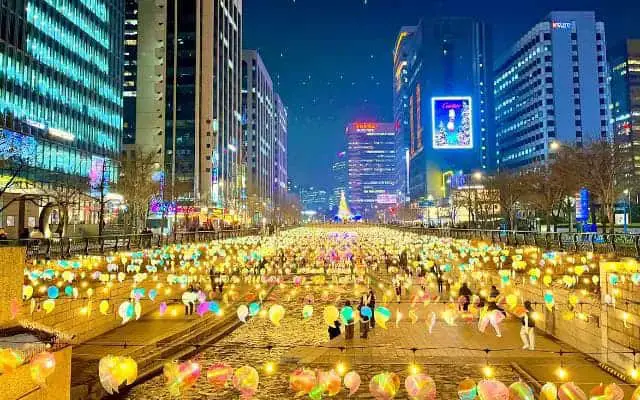
- Address: 1 Taepyeongno 1-ga, Jung-gu, Seoul
Cheonggyecheon Stream in Seoul is a great example of how a city can bring nature back to life. This 11-kilometer stream used to be forgotten, but now it’s a beautiful and lively place in the middle of the city. As I walked along the path, I loved how art and nature came together — it felt calm and refreshing, even in the busy city. At night, the stream lights up with colorful lights, making it feel almost magical. Cheonggyecheon is more than just a pretty place to walk — it shows how Seoul is working to build a greener, more peaceful city.
The real highlight is the annual Light Festival held every winter. Walking along the stream during this time is like stepping into a wonderland of lights and colors, making it an absolute must-visit if you’re in Seoul in December!
Cheongwadae (The Blue House)
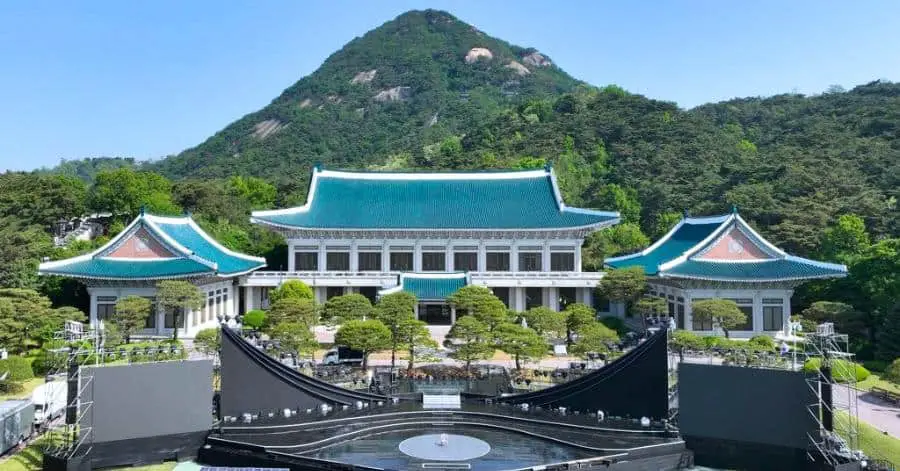
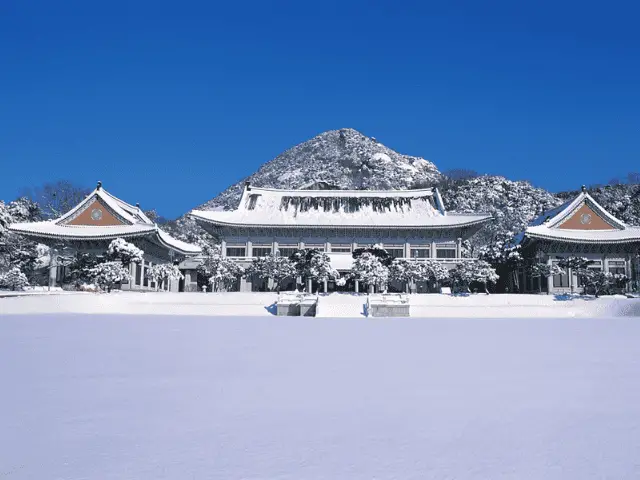
- Address: 1 Cheongwadae-ro, Jongno-gu, Seoul
- Visiting Hours: March-November 9:00 – 18:00 (Last admission for indoor viewing at 17:30) | December-February 9:00 – 17:30 (Last admission for indoor viewing at 17:00) | Closed on Tuesdays
- Admission: Free
- Tour’s operating hours: 09:00, 10:30, 12:00, 13:30, 15:00, 16:30
- Website: www.opencheongwadae.kr
Just a short walk from the palace, you’ll find Cheongwadae, also known as the Blue House — it used to be the official residence of the President of South Korea. While the main building isn’t open to the public every day, you can still visit Cheongwadae Sarangchae, a cultural center and museum nearby. It gives a nice glimpse into Korea’s modern political history, with exhibits about former presidents, Korean culture, and even cool international gifts they’ve received over the years. It’s a quick but interesting stop if you’re into history or want to learn more about the country’s leadership.
Samcheong-dong Café Street
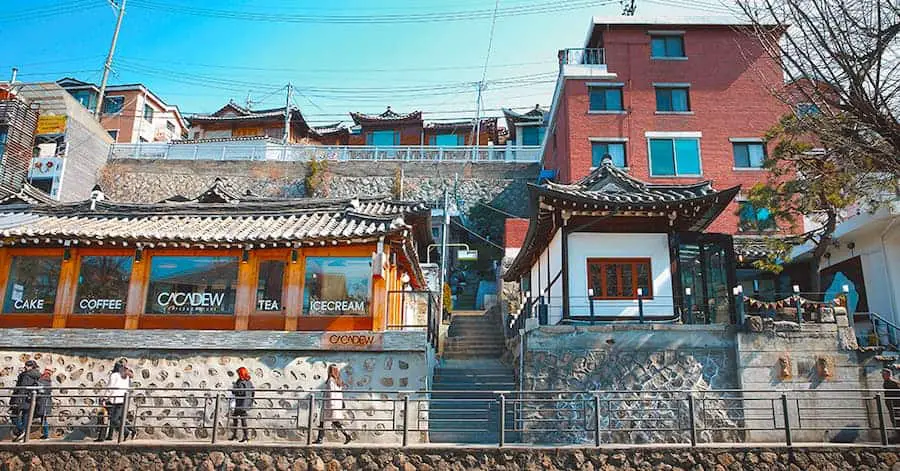
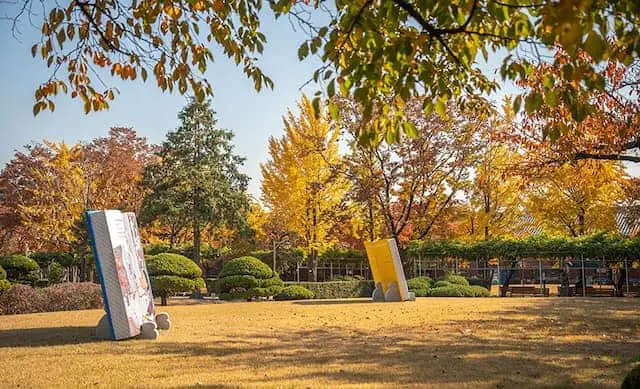
- Address: 107, Samcheong-ro, Jongno-gu, Seoul | 서울특별시 종로구 삼청로 107
Just on the other side of the palace, Samcheong-dong is a totally different vibe — quiet, artsy, and super photogenic. The area is full of charming hanok-style houses mixed with stylish cafes, local boutiques, and small galleries. It’s a great place to chill after walking around the palace. Grab a cup of coffee, explore a quirky shop, or just stroll through the peaceful streets. It’s especially pretty in the fall when the leaves start changing.
Where to stay near Gyeongbokgung Palace
Four Seasons Hotel Seoul
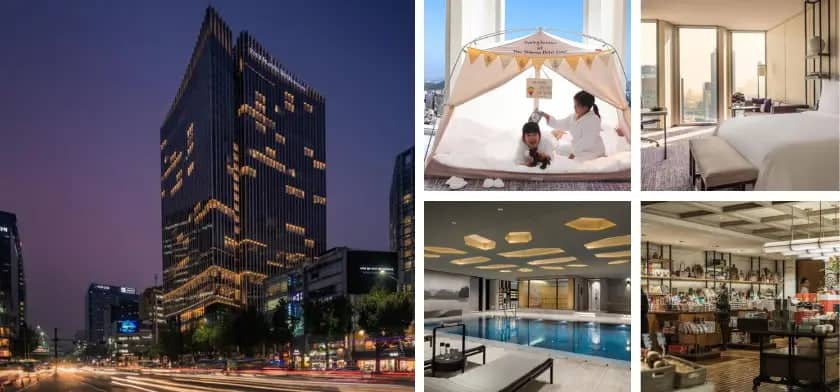
- Address: 97, Saemunan-ro, Jongno-gu, Jongno-Gu, 03183 Seoul, South Korea
- Phone: +82 2-6388-5000
- Website: https://www.fourseasons.com/seoul
- Check-in: from 15:00
- See the best price at Agoda.com (420 USD)
The Four Seasons Hotel Seoul is a top-notch luxury choice. Its spacious design, elegant decor, and modern amenities like pools and Korean saunas make it perfect for vacations or honeymoons. Every room offers panoramic views of Seoul through floor-to-ceiling windows, blending tradition and modernity.
Conveniently located near Seoul’s heart, it’s an ideal base for relaxation and exploration, with Gyeongbokgung Palace, Sejong Art Center, and Cheonggyecheon Stream just a brief 10-minute stroll away.
Highlights
- Swimming pool & fitness center
- Pet friendly
- Sauna & Hot tub
- Breakfast in room
- Bar, Restaurant, and Coffee shop
- 1.0 km from the Gyeongbokgung Palace
- 650m to the Seoul Museum of Art
Nine Tree Premier Hotel Insadong
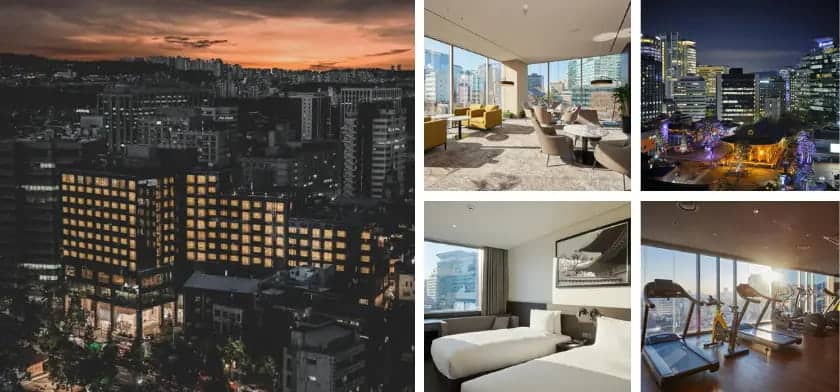
- Address: 49, Insadong-gil, Jongno-gu, Jongno-Gu, 03145 Seoul, South Korea
- Phone: +82 2-6917-3099
- Website: https://www.ninetreehotels.com/
- Check-in: from 15:00
- See the best price at Agoda.com ( 88 USD)
The Nine Tree Hotel in Insadong, just 790 meters from Gyeongbokgung Palace, is surrounded by the historic charm of older stores and cafes. The area is a favorite for locals and visitors alike. The hotel offers a view of Jogyesa Temple, only 60 meters away, providing a peaceful atmosphere to enjoy right from your room. Plus, with numerous restaurants inside and street food stalls nearby, it’s a great spot for a South Korean street cuisine adventure.
Highlights
- Korean food for breakfast
- Swimming pool & gym
- Spa and massage
- Tea/coffee maker in all rooms
- Bar, Restaurant, and Coffee shop
- 790m to Gyeongbokgung Palace
- 530m to Bukchon Hanok Village
Sunbee Hotel Insadong
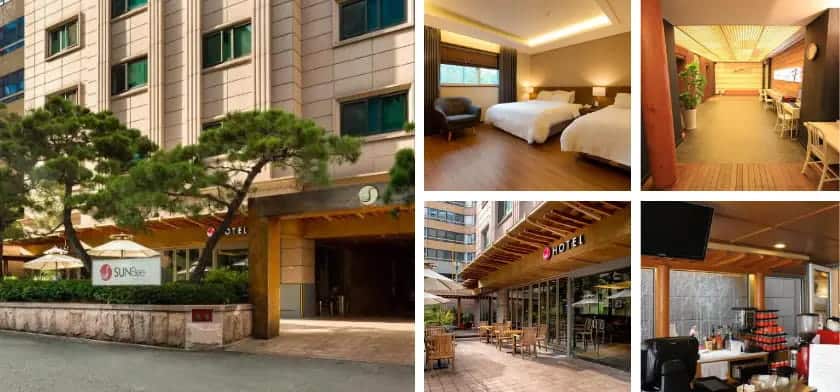
- Address: 26 Insadong 7-gil, Insadong, Seoul, South Korea
- Phone: +8227303451
- Website: http://www.hotelsunbee.com
- Check-in: from 15:00
- See the best price at Agoda.com (90 USD)
For a peaceful stay in the heart of Seoul, consider Sunbee Hotel Insadong. Conveniently located in the center of Insadong, it’s tucked away in a calm alley, providing a tranquil escape. Just 990 meters from Gyeongbokgung Palace, it’s an excellent base for sightseeing, with Seoul’s nightlife and attractions like Myeongdong Walking Street and Bukchon Hanok Village a short walk away. The cozy rooms offer comfortable night’s sleep amenities, including blackout drapes and air conditioning. Some rooms feature cable TV, and select options include bottled water, a coffee and tea maker, and a refrigerator.
Highlights
- Breakfast
- Doctor/nurse on call
- Bar, Restaurant, and Coffee shop
- Airport transfer
- 120 meters to Insadong
- 990m to the Gyeongbokgung Palace
For more options, check out our post about 10 best hotels and guesthouses near Gyeongbokgung Palace.
For more exciting places and activities in Korea, visit our website, iVisitKorea – your ultimate Korea travel guide!
You may also like:
- How to rent a Korean traditional dress Hanbok?
- Cheongwadae (Blue House): What To See & How To Get There
- 10 Best Hotels and Guesthouses in Seoul Near Gyeongbokgung Palace
IVK’s Top Picks – Day Tours, Tickets, and Travel Activities
Seasonal Picks!😍


